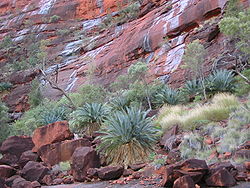| Macrozamia macdonnellii | |
|---|---|
 | |
| Macrozamia macdonnellii | |
 | |
| Scientific classification | |
| Kingdom: | Plantae |
| Clade: | Tracheophytes |
| Clade: | Gymnospermae |
| Division: | Cycadophyta |
| Class: | Cycadopsida |
| Order: | Cycadales |
| Family: | Zamiaceae |
| Genus: | Macrozamia |
| Species: | M. macdonnellii |
| Binomial name | |
| Macrozamia macdonnellii | |
 | |
| Occurrence data from AVH | |
Macrozamia macdonnellii, common name MacDonnell Ranges Cycad, is a species of plant in the family Zamiaceae. [2] It is endemic to the Northern Territory, Australia. [1] [2]
Contents
Macrozamia macdonnellii is not eaten by the Arrernte people of the Macdonnell Ranges due to the extensive process of toxin leaching that is required.
